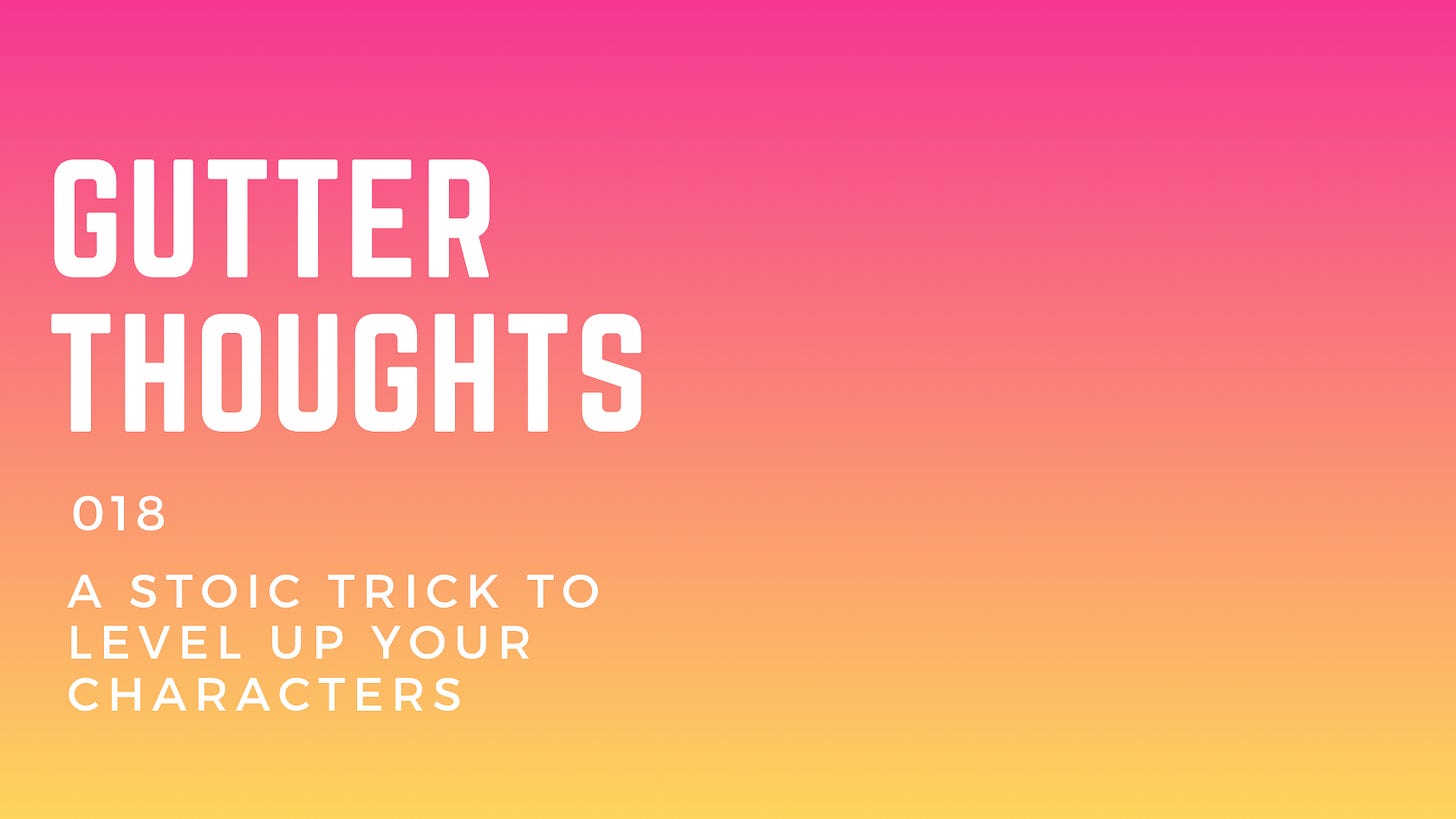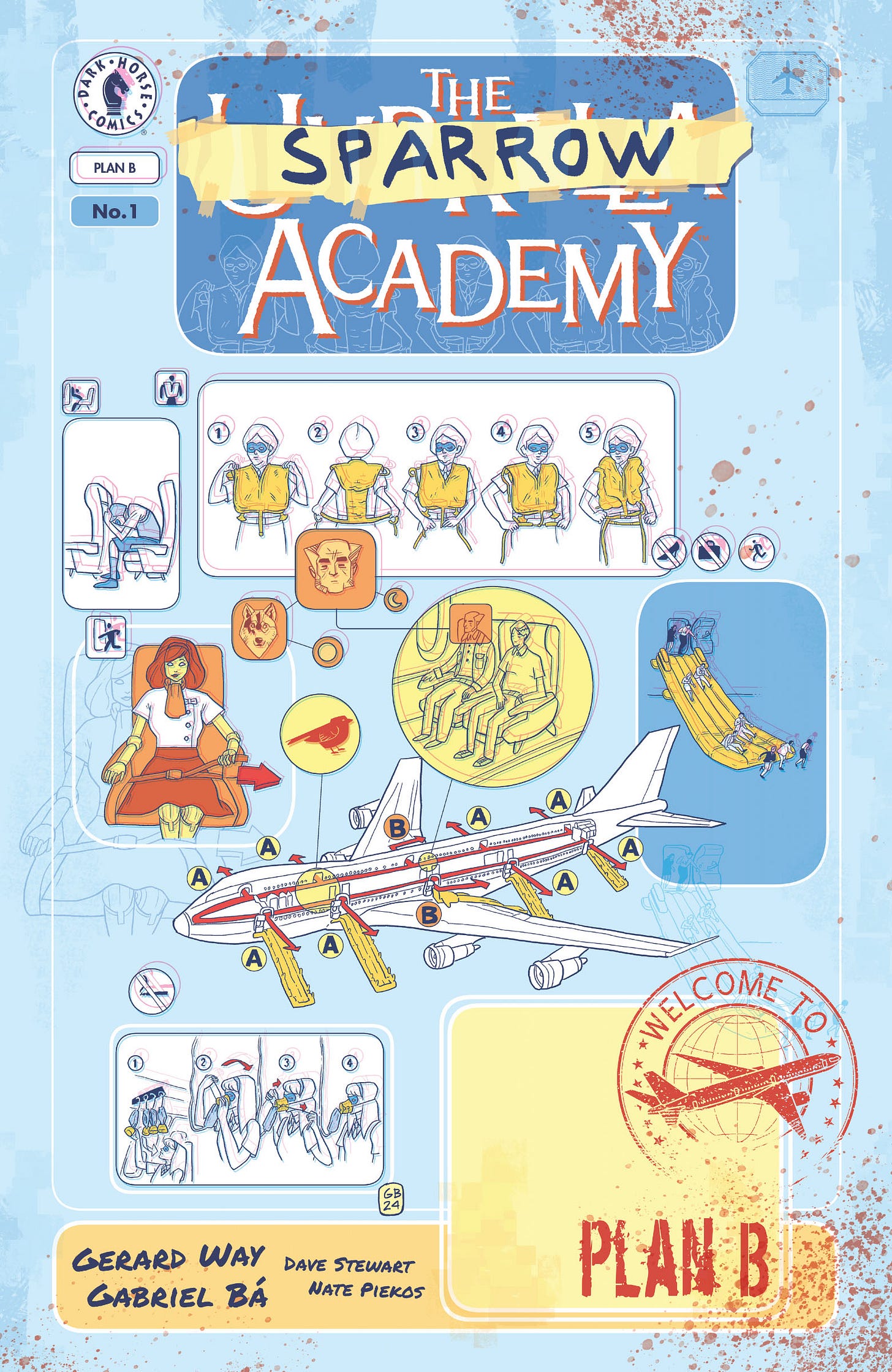Gutter Thoughts 018: A Stoic Trick to Level Up Your Characters
Why your story is stuck, and how journaling might have the answer.
Welcome to Gutter Thoughts, where I share insights into my creative process and philosophy each week. From exploring big ideas to finding inspiration in comics, books, shows, and movies, this space is all about staying creative and grounded.
Weekly Creative Focus
Whether diving into creative work or spending time learning and reflecting, here’s what’s been on the mind and plate this week.
A Stoic Trick to Level Up Your Characters
Plotting and character arcs can stall—especially for advanced creators who’ve already mastered the basics.
This week’s insight pulls from an unexpected place: Stoic journaling.
At its core? A deceptively simple method Marcus Aurelius used to examine his own inner contradictions, one that modern comic creators can use to reignite momentum in their storylines and character arcs.
Here’s the question worth asking:
What if the emotional block in your story isn’t in the character, but in you?
By the end of this post, you’ll learn the single daily prompt that gets your characters moving again, because it gets you moving again.
The Stoic Principle Behind the Problem
The Stoics believed that clarity in action comes from clarity in thought. Marcus Aurelius, arguably the most famous Stoic, used his journal not to record events, but to interrogate his own responses to those events.
His question was simple:
“What part of me is reacting?”
This was far from being self-indulgent. It was strategic. It helped him detach from unhelpful emotions and act from a clearer place.
Now imagine applying that lens to your protagonist. Or better yet—to the part of you that is stuck writing them.
Plot plateaus often aren’t structural. They’re psychological.
The stakes don’t feel real. The motivation feels weak. The climax doesn’t land. Why?
Because the writer’s internal state is muddy. And when the writer is unclear, the character can’t evolve.
But Can a Journal Prompt Really Fix a Character Arc?
Now, you’re probably thinking: “Sure, Stoic journaling is great for self-help. But how does that help me fix a second act that’s going nowhere?”
Here’s the thing about creative plateaus: They’re rarely about the story mechanics.
They’re more about your unwillingness to let the character face what you haven’t faced.
Don’t worry we’ll explore what that means and how to work through it.
The Exercise: The Mirror Method
This Stoic-inspired journaling practice is called The Mirror Method, and it works like this:
Step 1: Pick the scene or plot moment that’s giving you the most trouble.
It could be a turning point that falls flat or a character choice that feels forced.
Step 2: Ask yourself this Stoic-style question: “What part of me is avoiding this choice?”
Write down whatever comes up: shame, fear, boredom, confusion.
Step 3: Answer from your character’s voice: “What part of me is reacting right now?”
Let your character respond in a raw, uncensored journal entry.
Step 4: Compare both entries.
Where do your emotional hesitations and the character’s misdirection overlap? That’s your clue. That’s the block. That’s the truth you’ve been dodging.
Step 5: Rewrite the scene based on the emotional truth revealed.
Let the character say what you wouldn’t. Let them do what you’ve been resisting.
Sometimes we need to stop thinking so hard and start listening instead.
Get out of your head, and into your character’s. What are they truly struggling with? What frustrations are shaping their actions? And what path would they actually take to solve it?
Why This Works (And How I’ve Used It)
I used this exact method while plotting the antagonist for a comic I’m working on.
I couldn’t figure him out. I knew he needed to be the opposite of the protagonist, but I wasn’t sure how. Every version I tried felt flat—too abstract, too generic.
So I opened my notebook and used the Mirror Method.
First, I asked: “What part of me is avoiding this decision?”
Then I let the character respond: “What part of me is reacting right now?”
That’s when things began to become clear for me. I realized I was overthinking the concept instead of listening to the conflict.
My protagonist wants to lead quietly, from the shadows. The antagonist? Well, he wants the spotlight. Not to help people, but to be known. To be remembered.
That contrast wasn’t just strategic—it was emotional. And it gave the story its tension that was desperately needed.
I didn’t find that through plotting. I found it by getting honest on the page. That’s the power of this exercise. It doesn’t just help your character speak. It helps you get out of the way, so the story can move forward.
Conclusion: The Plot Isn’t Stuck—You’re Just Not Listening
Plateaus in storytelling don’t always mean your ideas are broken. Sometimes, they mean you’re resisting clarity.
And clarity starts by facing your own contradictions.
Here’s what we covered:
Stoics journaled to clarify emotion, not to vent.
Marcus Aurelius asked: “What part of me is reacting?”
You can ask: “What part of me is avoiding this scene?”
Use The Mirror Method to surface hidden resistance and emotional truth.
Let your characters tell the truth you’re afraid to say.
Try it this week.
Pick the scene you’re stuck on. Ask the question. Let the character answer. Then rewrite the moment from that new truth. You’ll develop a character arc with emotional weight. While becoming a writer with a clearer vision.
After you’ve made a breakthrough hit reply and share what you’ve unlocked.
This Week’s Creative Sparks
Here are the shows, books, movies, comics, and more that have sparked my creativity this week:
Video Game Spark: Invincible VS Official Reveal Trailer
This past week I saw the trailer for a new game—and my jaw hit the floor. This gem came out of nowhere and smacked us in the face (in the best way).
The trailer kicks off bloody, hilarious, and full of energy. The animation has a stop-motion vibe, and the voice acting sounds just like the show.
As a longtime Invincible fan, it made me genuinely happy. Even though the comic ended years ago, the universe keeps giving. It's hands down some of the best superhero content ever created.
Basketball Spark: Luka Doncic in the gym lifting weights and Victor Wembanyama practicing as a Monk
One thing you should know about me: I’m deeply inspired by sports—especially basketball.
Right now, I’m working on a basketball-themed comic, and this short video lit a creative spark. Watching two young athletes push themselves to the limit felt like something straight out of an anime.
It gave me a few new plot ideas on the spot. Trust me, this one’s already saved to my swipe file.
Comic Book Spark: The Umbrella Academy: Plan B
Gerard Way is easily one of my top five comic writers of all time. He just gets storytelling—whether through music or comics, he always delivers something epic. And Gabriel Bá? He keeps blowing me away with artwork that feels simple at first glance but reveals so much depth on every page.
So when Umbrella Academy returned for Volume 3, I was all in. Like always, I start the first issue thinking, “Okay, this is cool,” and by the end, I’m saying, “Holy shit, this is gonna be a wild ride.”
I’m especially hyped for this installment because we finally get to dive deeper into the comic book version of the Sparrow Academy.
Animation Spark: PUNCH PUNCH FOREVER! - Toothless Aggression
Punch Punch Forever is an animated series I stumbled across on YouTube—and from the first episode, I was hooked.
Created by Speedo, the show feels like a Saturday morning cartoon with a twist. It’s got that gritty VHS aesthetic, complete with static, fake ads, and the most random cameos. It’s the kind of weird, offbeat humor you’d expect from Adult Swim—and exactly the kind I live for.
What makes it even cooler? Speedo still publishes his work on Newgrounds. The animation is wild, the art is amazing, and he’s quickly become one of my creative inspirations.
If you want to dig into his process, especially for this episode, I highly recommend reading his post-production wrap-up.
The Stoic Quote of the Week
A Stoic quote to inspire and motivate, helping to stay grounded in the creative process.
“In this way you must understand how laughable it is to say, ‘Tell me what to do!’ What advice could I possibly give? No, a far better request is, ‘Train my mind to adapt to any circumstance.’ . . . In this way, if circumstances take you off script . . . you won’t be desperate for a new prompting.”
—EPICTETUS, DISCOURSES, 2.2.20b–1; 24b–25a
This quote stood out to me this week.
As Ryan Holiday points out in The Daily Stoic, we can’t rely solely on external instruction. Constantly searching for the “perfect” answer or fix only leaves us stuck.
Instead, we need to pause, look within, and trust what we’ve already learned. Spend time in solitude. Write down what’s on your mind. And then, most importantly, put it into practice.
That’s where real breakthroughs happen. Not from more advice. But from taking ownership.
What’s one lesson you’ve learned recently that you haven’t put into practice yet?
That’s a wrap for this week’s Gutter Thoughts. Thanks for joining me on this creative journey—hopefully, something here sparked an idea or inspired your own work. Until next time, stay grounded, stay creative, and keep pushing forward.
Let’s Connect
Enjoying Gutter Thoughts?
Imagine having emails like this crafted specifically for your brand or business. Whether you’re a creative storyteller or a brand strategist, I’ll help you turn your unique voice and ideas into engaging, value-packed content.
Ready to level up your email game? Let’s talk about how we can co-create emails that captivate your audience and drive real results.



